Tropical hibiscus (Hibiscus rosa-sinensis) is a delightful ornamental shrub with large, showy flowers that thrives in hot, humid climates.
But they also make excellent container plants, so those of us in temperate areas can enjoy them too!

We link to vendors to help you find relevant products. If you buy from one of our links, we may earn a commission.
Pollinators ranging from bees to hummingbirds are drawn to the large flowers that come in richly saturated shades of apricot, gold, mauve, peach, pink, purple, scarlet, and white – with more orange-based colors than their hardy cousin, the rose mallow (H. moscheutos).
Easily cultivated in pots and planters, they prefer to have their roots in close quarters, so containers don’t have to be huge.
They also respond well to annual pruning to maintain a well-behaved size and shape.
This makes the seasonal move inside and back outdoors convenient and manageable – no need for a forklift to move them into the orangery!
Steamy colors, evergreen foliage, and easy care… is your garden ready for some potted beauty? Then let’s delve into the ins and outs of how to grow tropical hibiscus in containers!
Here’s what’s ahead:
What You’ll Learn
Tropical Hibiscus Primer
Tropical hibiscus is native to Asia and some islands of the South Pacific.
A frost-tender perennial evergreen also known as Chinese, fancy, or Hawaiian hibiscus, it’s a perennial in USDA Hardiness Zones 9 to 11, where the plants flower abundantly through the growing season.
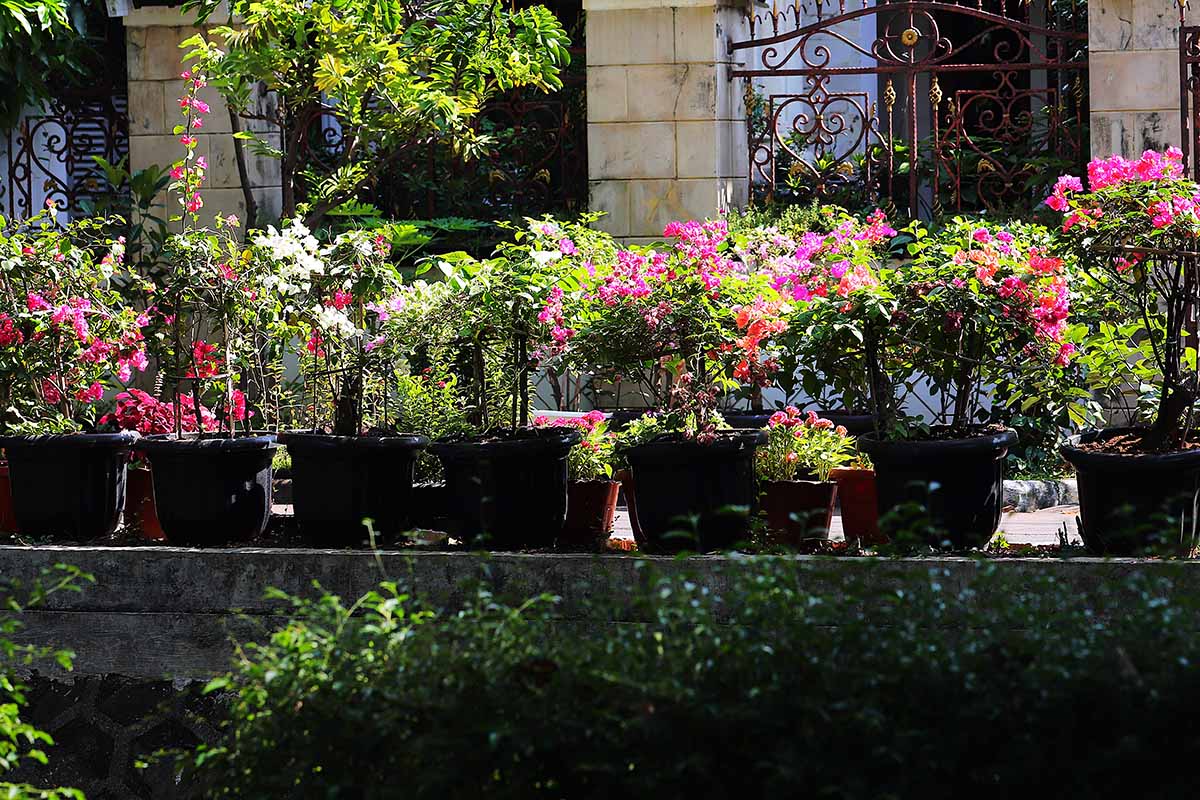
A member of the mallow family, Malvaceae, H. rosa-sinensis produces large, luscious blooms measuring four to six inches in an array of thrilling colors, with over 10,000 known hybrids!
The large, funnel or trumpet-shaped flowers are edible and available in single or double forms that last only a day.
But the shrubs are so loaded with buds, it’s like they’re in perpetual bloom over the long flowering season, which starts in spring and lasts to late fall in frost-free regions.
These evergreens do best in temperatures ranging from 60 to 90°F and can grow from two to 30 feet tall. For container growth, dwarf or compact cultivars are the best option.
Container Selection
Hibiscus does well in any type of planter, including those made of materials such as ceramic, concrete, plastic, resin, terra cotta, or wood.

But if you need to move pots indoors or into a sheltered location to overwinter, lightweight materials like fiberglass, hypertufa, or resin makes good sense.
And you can always put heavier pots on a wheeled plant caddy to make moving them easier.
This round wooden caddy offers heavy-duty support for up to 65 pounds and is available at Wayfair.
If you prefer containers made of heavier materials, a simple pot lifter harness is invaluable.
It takes two people to use, but these offer a brilliant solution for moving large or heavy items – ours are used in the garden each spring and fall, and they’re aces for shifting boulders or hauling driftwood!

The Shoulder Dolly pot lifter with an 800-pound capacity can be found on Amazon.
Choose a pot that is one or two sizes larger than the root ball.
For example, if your plant came in a #1 nursery pot, which holds close to one gallon of soil, transplant into a container that holds up to two or even three gallons of soil, but don’t go larger than that.
H. rosa-sinensis has wide, shallow roots. When planted in a container that’s too large, this species can’t absorb all of the available moisture, which can result in root rot.
For healthy plants, it’s best to repot every two or three years, increasing the pot size gradually.
Whatever material you choose, ensure your container has drainage holes to prevent the soil from becoming waterlogged.
I like to add a two-inch layer of loose materials like broken pottery or pebbles over the drainage holes to ensure the roots don’t sit in wet soil.
Tropical Hibiscus Cultivars to Select
With hundreds of cultivars out there, there are plenty of options suitable for container growth. Here are a few suggestions to start out with:
Double Peach
All bets are off as ‘Double Peach’ doubles down on charm and petals, featuring sumptuous, ruffled flowers of peachy orange with deep green, shiny leaves.
Flowering all summer, ‘Double Peach’ has an upright habit and grows up to six feet tall with a spread of up to five feet.
A striking specimen in containers and planters or massed in groups or rows as a barrier or screen, it’s hardy in Zones 9 to 10.
Nursery plants are available from Walmart.
Red Dragon
No slaying is required to enjoy the brilliant, fiery red blooms of Red Dragon (‘Mongon’)!
A profuse summer and fall bloomer, the double-petal, ruffled flowers add dramatic appeal to bushy, upright branches thick with glossy green leaves.
Growing six to eight feet tall with a spread of three to four feet, Red Dragon makes a beautiful addition to patio planters and containers throughout the garden.
Prune lightly in spring to encourage branching, improve flowering, and keep the size and shape manageable. Hardy in Zones 10 to 11.
Nursery containers are available at Nature Hills.
Starlette
Roll out the red carpet and get your cameras ready for Starlette (‘14014’) – with a lead role in the Hollywood series, the gorgeous coral/fuchsia pink flowers steal the show!
Bred for abundant flowers all summer, the multi-branched plants grow up to five feet tall with a spread of one to four feet – the perfect planter choice for courtyards, decks, patios, and poolside gardens. It’s hardy in Zones 10 to 11.
Containers of Starlette are available at Nature Hills Nursery.
Tree
For a striking accent, these tropical hibiscus trees have been sculpted into a standard topiary form that’s a natural in containers, planters, and urns.
Loaded with flower buds through summer and fall, the single-petal flowers in red or pink add bright, bold colors that look terrific as a potted specimen or clustered into larger groupings.
The trees reach a mature height of six to eight feet with a two- to three-foot spread. Hardy in Zones 9 to 11.
Nursery trees measuring three to four feet are available at Fast Growing Trees in red and pink.
Yellow Bird
Your fancy will take flight on the wings of ‘Yellow Bird,’ a charming dwarf variety featuring extra large, buttercup yellow flowers with an eye-popping magenta heart.
These compact plants grow two to three feet tall, spread up to two feet, and feature flowers measuring up to eight inches across!
An ideal container plant as an anchor for mixed plantings or roosting alone as an accent or specimen, it’s hardy in Zones 9 to 10.
Soil and Growing Needs
Tropical hibiscus does best in a full to partial sun location and needs well-draining, slightly acidic soil with a pH of 6.5 to 6.8.
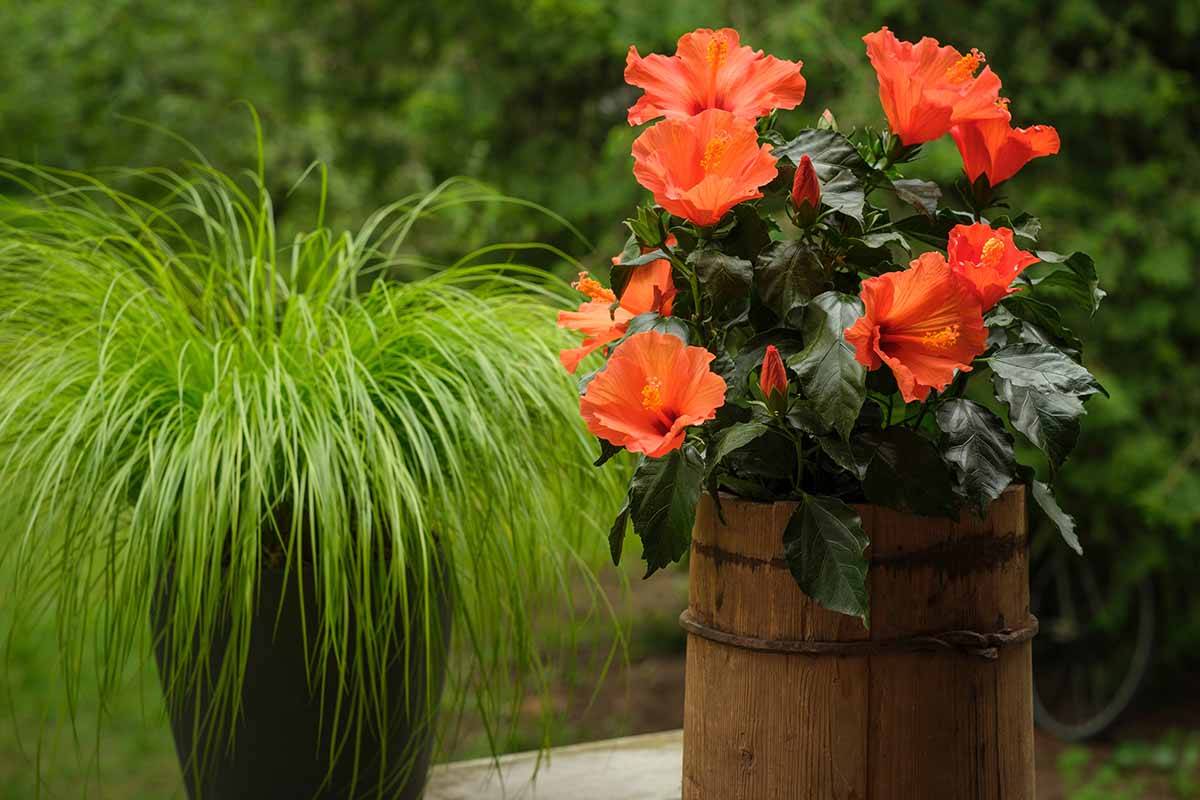
Plant out in spring after overnight temperatures stay above 55°F.
Fill pots with a friable, well-draining soil blend that’s been amended with one or two parts compost or well-aged manure to two or three parts soil. (A “part” is just a measurement unit for the ingredients – I use a shovelful to measure out one part.)
Mix in one part moisture-retentive materials such as coconut coir, peat moss, perlite, or vermiculite.
Add in one part grit to improve drainage if needed, using landscape sand, pea gravel, or stone chips.
Water lightly and mix the soil at the same time for a moist planting medium.
Finish off the soil blend by mixing in two to three tablespoons of bone meal for fast, healthy root growth.
Create a planting hole for the root ball and set the plant in place with the crown at soil level or just above it.
Firm in place and water slowly but thoroughly until water comes from the drainage hole.
Although these plants are sun-lovers, it’s helpful to harden off newly planted shrubs in a partially shady spot for 10 to 14 days before moving them into full sun.
Once hardened off, place containers in a site that receives full sunlight and provide afternoon shade in hot climates as needed – typically in locales where temperatures climb above 90°F.
To deal with pests like aphids and diseases like gray mold, our guide on how to grow and care for tropical hibiscus has details and solutions.
Fertilizing and Watering
Feed on a monthly basis with a water-soluble fertilizer or apply slow-release, granular pellets in early spring and again in midsummer.
Hibiscus does best with a feed that features high levels of potassium, medium amounts of nitrogen, and low levels of phosphorus – look for NPK formulas with a low middle number (P), and the last number (K) slightly higher than the first (N).
Try this 4-1-5 NPK fertilizer from Espoma that’s designed for hibiscus and palms – it’s available in four-pound bags from Walmart.
During the growing season, water regularly to keep the soil lightly moist but not wet. Check your pots every couple of days – daily in hot weather – and water when the top inch of soil dries out.
The addition of a layer of summer mulch can be helpful to keep roots cool and retain moisture.
Use up to four inches of materials such as bark mulch, sawdust from untreated lumber, straw, or small pebbles to mulch over the root zone.
Outdoor Winter Care
H. rosa-sinensis thrives in hot, humid climates with plenty of sun and a temperature range of 60 to 90°F, or in Zones 9 to 11.

In the cool end of that range, in Zone 9, you can move potted plants into a protected location like a shed or garage should a cold snap threaten – they can’t tolerate temperatures below 45°F.
If moving them isn’t an option, add a thick, four-inch layer of mulch using materials such as compost, leaf mold, or straw to help protect surface roots.
Wrap the plant with a couple of layers of frost blanket material to protect leaves and stems from freezing temperatures.
And you can shield deeper roots by insulating the container with an old blanket, bubble wrap, or pine boughs.
Withhold fertilizers from outdoor plants over the winter and reduce watering where rainfall is ample. In drier regions, maintain slightly moist soil.
In areas with heavy winter rainfall, remove catchment saucers from under containers to avoid subjecting the roots to standing water.
If needed, lift containers onto bricks or pot toes to ensure water doesn’t puddle under the pots.
Indoor Winter Care
A couple weeks before nighttime temperatures drop down to 60°F, move containers into a shady spot for two weeks to prepare them for the move indoors.
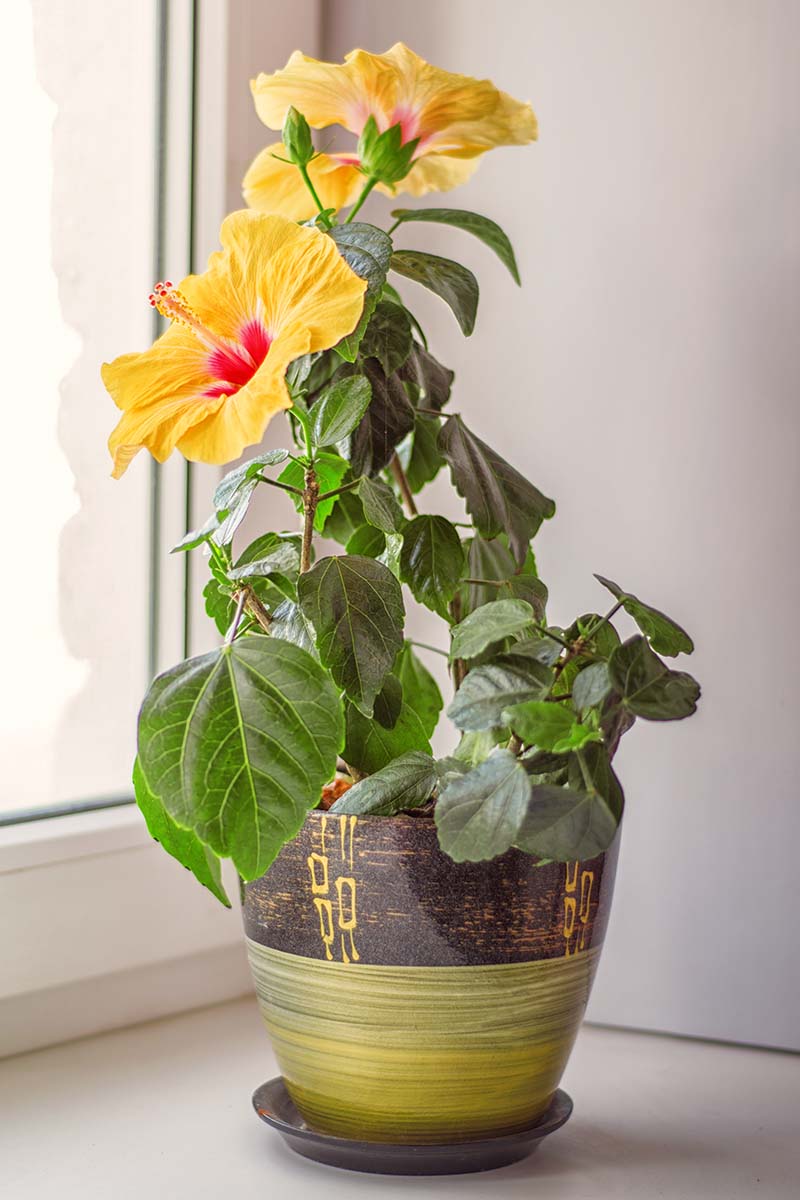
Moving plants indoors usually results in some leaf drop or yellowing leaves, but they recover quickly and bounce back in a few weeks.
But before bringing your pots indoors, prune lightly if needed and check for pests.
If pests are found, spray the foliage with a strong stream of water from the hose or spray with a gentle homemade insecticide.
To make your own insecticidal soap, fill a spray bottle with lukewarm water mixed with a few drops of mild dish soap and a few drops of vegetable oil.
Shake well then spritz the infested leaves, ensuring you spray the undersides.
After the foliage dries, place your container in a warm spot with bright, direct sunlight and away from drafts.
For indoor watering, fertilizing, and care details, refer to our guide on how to overwinter tropical hibiscus indoors.
After Winter
In spring, once nighttime temperatures stay above 55°F, move containers back outdoors.
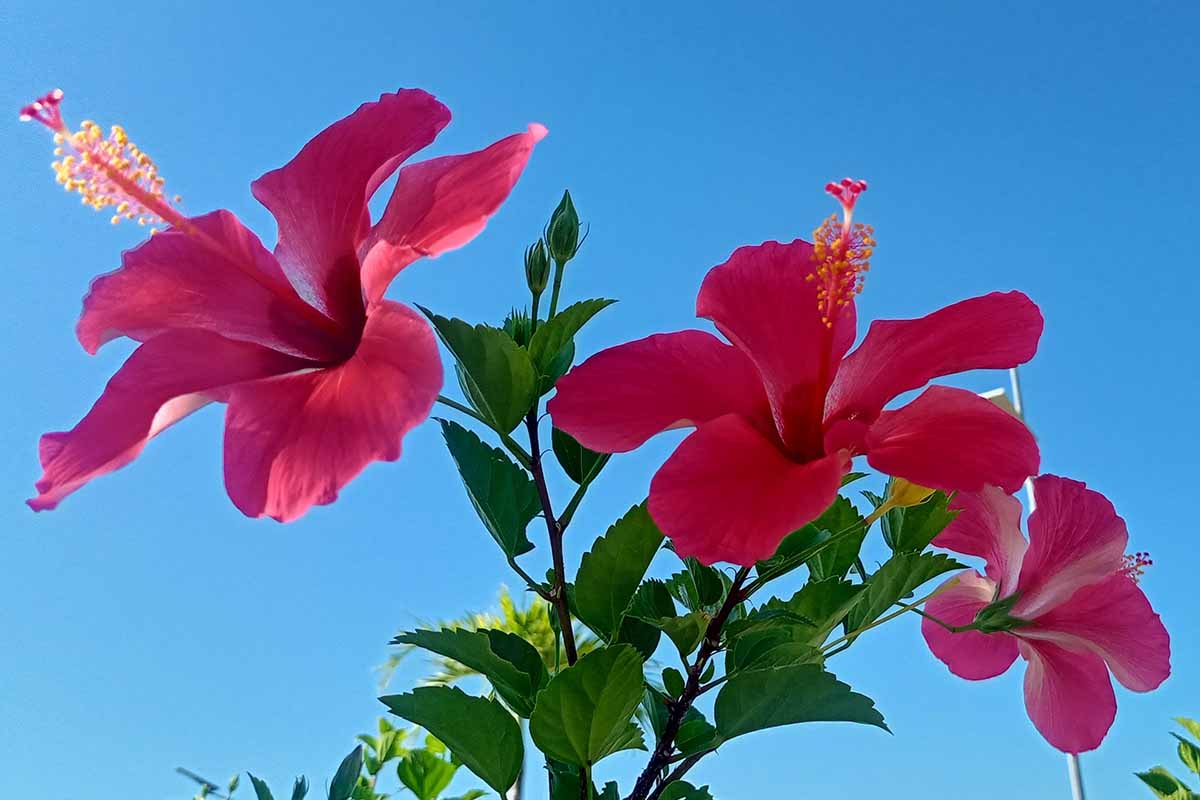
Place them in a lightly shaded spot for 10 days to two weeks to harden them off from their indoor climate.
Prune lightly, using clean, sharp garden shears to reduce the overall size by up to one-third, cutting stems on an angle just above a leaf node. At the same time, remove any crossed, dead, or damaged branches.
After hardening off, move to their summer location and resume a regular feeding and watering routine.
Nonstop Showy Displays
Potted frost-tender hibiscuses thrive with a little attention, delivering a long season of lush foliage and showy tropical flowers.
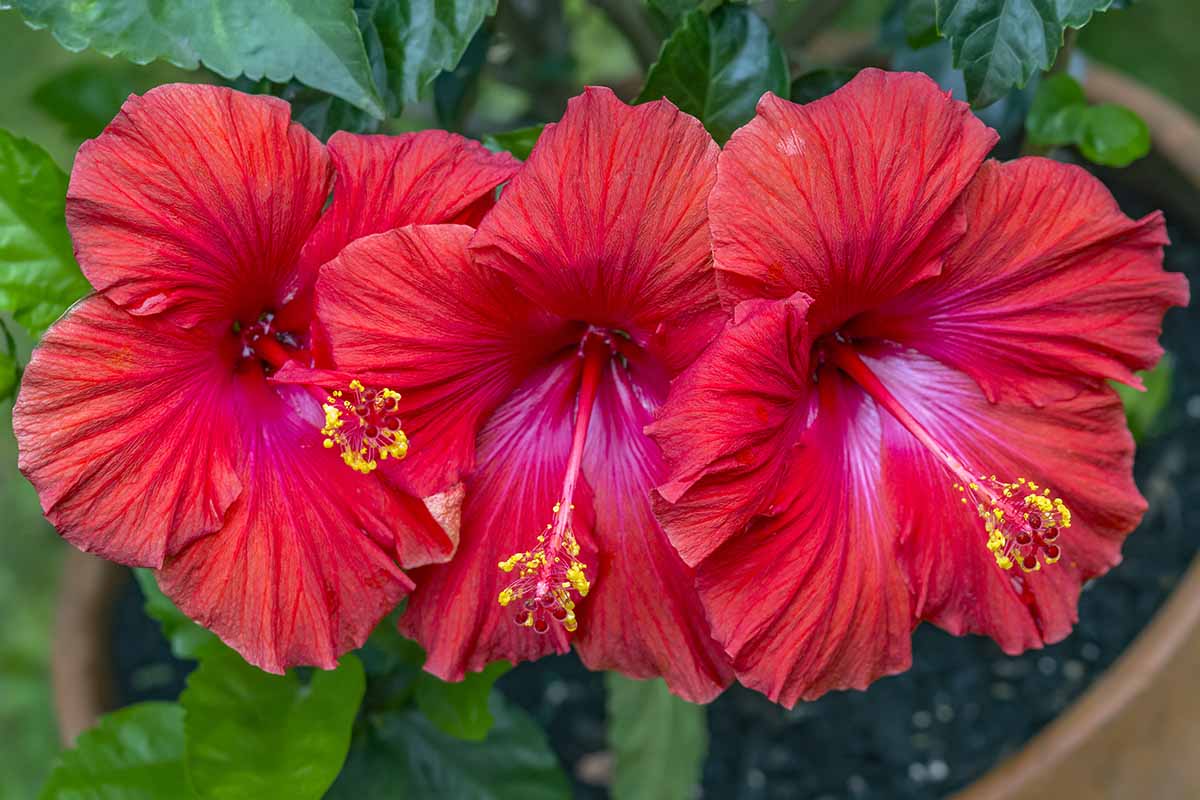
For a nonstop container display, keep the soil lightly moist, fertilize regularly, and provide shade from hot afternoon sun – then reap the rewards of well-tended plants!
And if you’re outside of their hardiness range, be sure to bring them indoors to overwinter.
Do you folks have a favorite variety of potted tropical hibiscus? Tell us about it in the comments section below.
And for more information about growing other types of hibiscus, check out these articles next:
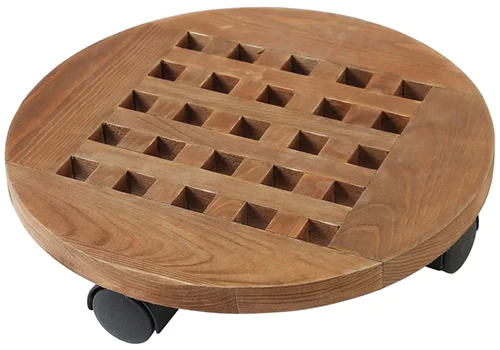
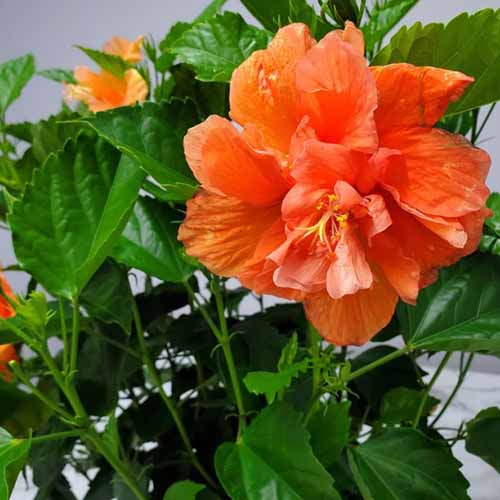
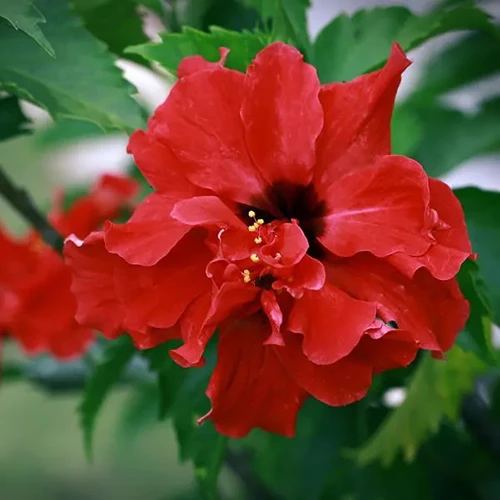

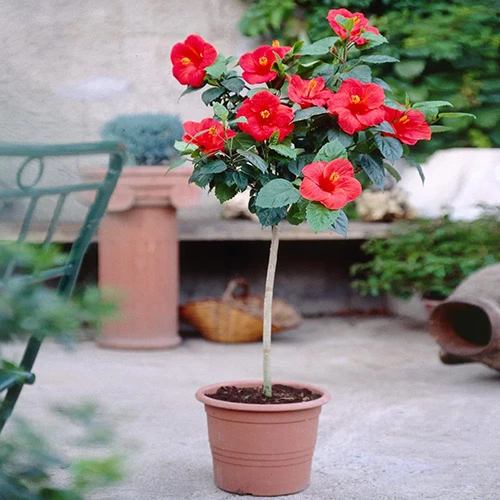
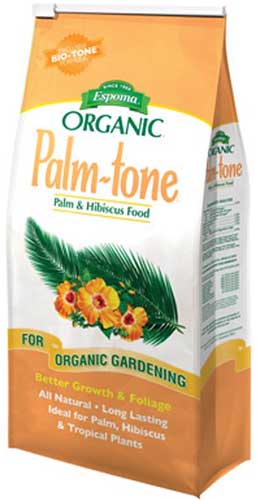

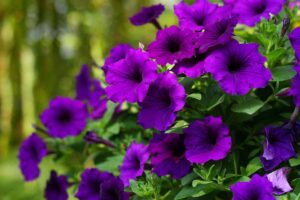
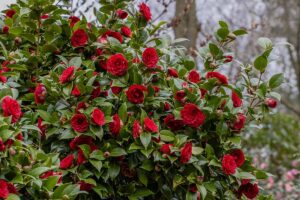
We bought our first hibiscus tree this year and are enjoying the beautiful flowers. The tree faced some heat distress while we were on vacation for one week but seems to be coming back nicely.
Thank you for all of the great information on general care and especially bringing hibiscus indoors once night temps are below 60 degrees. We are in zone 7 so we will be prepared.
Thanks for reading Marie!